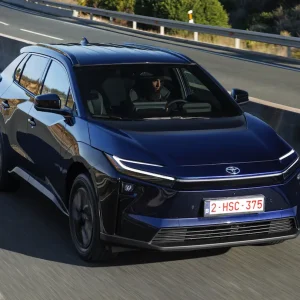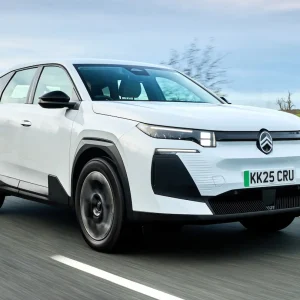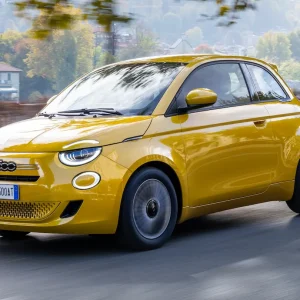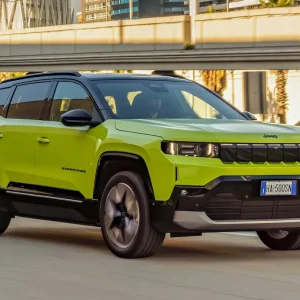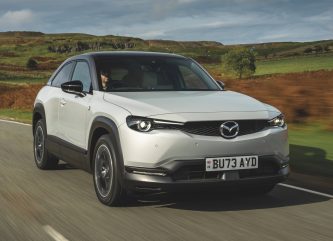
As much as the car industry likes to talk about innovation, it’s rare for us to come across something genuinely new. But that’s what we have with the Mazda MX-30 R-EV – a rotary range extender EV.
We’ll tackle the rotary element of that first. Rotary engines – petrol engines based around rotors as opposed to up-and-down pistons – have been a pet project of Mazda’s for decades, mostly deployed in sports cars, with the most recent, the RX-8, ending production in 2012. However, Mazda believes it has now found a job for which rotary engines are perfectly suited, which brings us to the range extender element. There are similarities with a plug-in hybrid – an electric motor is paired with a petrol engine, with a fairly modest battery-only range (53 miles in the Mazda’s case) but without range anxiety because the petrol engine is on hand to step in, although regularly plugging-in and charging is the most efficient operating method. However, where with a plug-in hybrid both the engine and motor can drive the wheels, with a range extender the engine delivers no direct drive, and is purely used to top up the battery.
According to Mazda, rotary engines make good range extenders, because compared with conventional petrol engines they are smaller (only 830cc in the case of the MX-30), lighter, and run more smoothly – crucial qualities given that it’s really only meant as a back-up for EV charging and running.
So, how does this work on the road? Well, the exact parameters depend on which of the selectable drive modes is chosen. When the ‘normal’ mode is selected, the MX-30 operates as an EV only until the battery level drops to 43%. Alternatively, ‘EV’ mode allows the battery level to drop to near zero. In both modes, the engine is also called on under heavy acceleration, bypassing the battery and directly assisting the motor (the engineering here can be tough to grasp, but we think it’s best thought of as a reverse mild hybrid at these times).
When the rotary engine does start, it comes in smoothly and doesn’t sound intrusive – there is no big booming sound as can occur with plug-in hybrids, and also no sense of disconnection between the throttle pedal and engine note as we might have feared. However, around town when battery levels are low the sound does acquire more of a droning quality, which is not the most pleasant and fairly conspicuous. With the 170hp electric motor (more powerful than the motor in the existing electric MX-30) powering the wheels, performance is absolutely fine for an SUV of this type. Overall, it’s a harmonious-feeling set-up.
There’s more good news on the road, as the MX-30 handles well, with crisp steering, and it feels nicely planted in corners, while the ride is sportily firm but not uncomfortable.
Even on the entry-level Prime-Line equipment grade we tested (mid-range Exclusive-Line is pictured), the MX-30’s cabin is well-trimmed, with leather and some interesting materials such as cork and recycled fabric.
Since BMW is now moving away from using a rotary controller for its infotainment, Mazda’s system which retains this is now arguably the most intuitive system on the market to use while driving, and its continued presence is certainly welcome. In the MX-30 the main 8.8in screen sits above an Audi-style 7in screen for controlling climate functions, and this also works well.
For a medium SUV, possibly the MX-30’s weakest aspect is practicality – despite the neat provision of a large storage tray beneath the gear selector. Rear leg room feels a bit tight, with a relatively high floor meaning passengers sit with their knees quite high up, and tall adults will find headroom compromised. There’s also a question over the rear doors, which are rear-hinged, aping the set-up from the old RX-8. On the plus side, this looks very cool, but because the front seatbelts are mounted on these doors, front seat occupants have to unplug before rear passengers can get in or out. A 350-litre boot is also not that impressive.
Although the MX-30 R-EV’s official fuel economy figure looks poor, regular plugging in should enable drivers to beat it by far (range extenders tend to perform poorly under WLTP testing relative to PHEVs). Allowing for this, and noting that the Mazda is cheaper than any PHEV on the market except the MG HS (and comes in at thousands less than most), we would conclude that the MX-30 R-EV is far from a gimmick – for some it could make a lot of sense as a PHEV alternative.
Mazda MX-30 R-EV Prime-Line
P11D: £31,195
Residual value: 42%
Depreciation: £18,020
Fuel: £11,435
Service, maintenance and repair: £1,806
Cost per mile: 52.10p
Fuel consumption: 37.2mpg
CO2 (BIK %): 21g/km (8%)
BIK 20/40% a month: £42/£83
Luggage capacity: 350 litres
Engine size/power: 170hp electric motor with 17.8kWh battery and 830cc range extender rotary petrol engine

